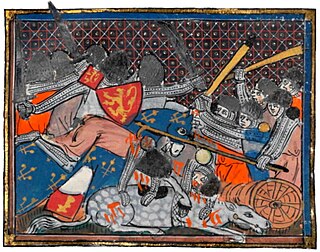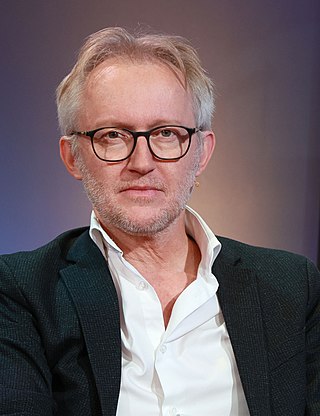
Margaret of York, also known by marriage as Margaret of Burgundy, was Duchess of Burgundy from 1468 to 1477 as the third wife of Charles the Bold, and after his death (1477) acted as a protector of the Burgundian State. She was a daughter of Richard, 3rd Duke of York, and of Cecily Neville, and the sister of two kings of England, Edward IV and Richard III. Born at Fotheringhay Castle, Northamptonshire, in the Kingdom of England, she died at Mechelen in the Low Countries.

The Battle of the Golden Spurs or 1302 Battle of Courtrai was a military confrontation between the royal army of France and rebellious forces of the County of Flanders on 11 July 1302 during the 1297–1305 Franco-Flemish War. It took place near the town of Kortrijk in modern-day Belgium and resulted in an unexpected victory for the Flemish.

Jan Anna Gumaar Ceulemans is a Belgian former professional footballer who played as midfielder. A prolific goalscorer, Ceulemans was known for his stamina, aerial ability, technique and was also recognized as one of the greatest Belgium footballers of all time. He was also known for his power, imposing frame and natural authority.

Franky Van der Elst is a Belgian retired professional footballer who played as a defensive midfielder. He later worked as a manager.

The College of Europe is a post-graduate institute of European studies with its first campus opened in Bruges, Belgium, a second campus located in Warsaw, Poland, and a third one established in Tirana, Albania.

Hugo van der Goes was one of the most significant and original Early Netherlandish painters of the late 15th century. Van der Goes was an important painter of altarpieces as well as portraits. He introduced important innovations in painting through his monumental style, use of a specific colour range and individualistic manner of portraiture. From 1483 onwards, the presence of his masterpiece, the Portinari Triptych, in Florence played a role in the development of realism and the use of colour in Italian Renaissance art.

Paul Guillaume van Himst is a Belgian former football player and a football manager who played as a forward, most notably for R.S.C. Anderlecht. Regarded as Anderlecht's ultimate club icon, Van Himst holds the record of four Belgian Golden Shoe awards and was named best "Belgian footballer of the twentieth century".

Peter Verhelst is a Belgian Flemish novelist, poet and dramatist. He won the Ferdinand Bordewijk Prijs for Tongkat.
Lorenzo Jules Staelens is a Belgian professional football manager and former player. He most recently coached Dutch club HSV Hoek.

Louis de Bruges, Lord of Gruuthuse, Prince of Steenhuijs, Earl of Winchester, was a Flemish courtier, bibliophile, soldier and nobleman. He was awarded the title of Earl of Winchester by King Edward IV of England in 1472, and was Stadtholder of Holland and Zeeland 1462–77.

A Joyous Entry is a ceremonial event marking the entry into a city by a monarch, prince, duke, or governor in parts of modern-day Belgium. Originating in the Middle Ages, it generally coincided with the affirmation or extension of the city's civic rights and privileges.
Belgium was represented at the Eurovision Song Contest 1996 with the song "Liefde is een kaartspel", composed by John Terra and Siirak Brogden, with lyrics by Daniël Ditmar, and performed by Lisa del Bo. The Belgian participating broadcaster, Flemish Belgische Radio- en Televisieomroep Nederlandstalige Uitzendingen (BRTN), selected its entry through a national final.

David Grégoire Van Reybrouck is a Belgian cultural historian, archaeologist and author. He writes historical fiction, literary non-fiction, novels, poetry, plays and academic texts. He has received several awards for his works, which include Congo: The Epic History of a People and Revolusi.
The Folklore of Belgium is extremely diverse and reflects the rich legacy of cultural and religious influences which have acted on the region throughout its history, even before the establishment of the nation of Belgium in 1830. Much of Belgian folklore is unique to the region in which it is commemorated. Many aspects of folklore are manifested in public processions and parades in Belgian cities; traditions which are kept alive for the amusement of locals and tourists alike.

Bruges is the capital and largest city of the province of West Flanders in the Flemish Region of Belgium, in the northwest of the country. It is the sixth most populous city in the country.

Lieven van Lathem (1430–1493) was an Early Netherlandish painter and manuscript illuminator.

Anselm Adornes, also known as Anselm Adorno, was a merchant, patron, politician and diplomat, who belonged to the fifth generation of the Adornes family to live in Bruges.
Events in the year 1902 in Belgium.
The following is a timeline of the history of the municipality of Bruges, Belgium.
Olivia Geerolf was a Belgian choreographer. She founded the Bruges Ballet School in Bruges in 1970. Between 1971 and 2015, Geerolf was the permanent choreographer of the Procession of the Holy Blood and of the five-yearly Procession of the Golden Tree in Bruges. In 2015, the choreography of the Procession of the Holy Blood was taken over by her former student Jolien Smis.














